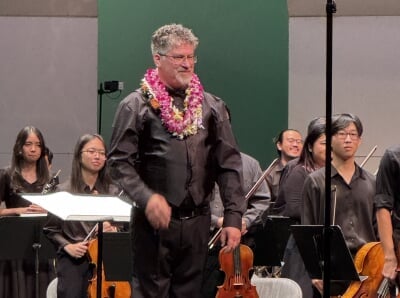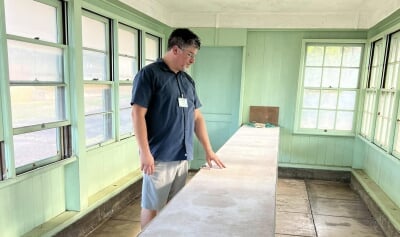Two decades of research into his family's place in Hawaiian history inspired a Michigan Tech professor of music to create the tone poem "Kalaupapa" — his first musical composition.
Researchers often pursue topics they are connected to. In the case of longtime conductor and first-time composer Joel Neves, inspiration struck a deeply personal chord, bound by a sacred promise. Neves, a professor of music in Michigan Technological University's Department of Visual and Performing Arts, spent more than 25 years researching his family's genealogy and discovering the fate of his Hawaiian ancestors. The painful truth he uncovered is the inspiration for his tone poem "Kalaupapa," which he recently conducted with the University of Hawai'i Symphony Orchestra at Kennedy Theatre in Honolulu, Hawaii.
After contracting Hansen's disease, also known as leprosy, Neves' great-great-grandparents Manokalanipo and Mele Kaina Nahiolea were quarantined for life on the Kalaupapa Peninsula of Moloka'i in Hawaii. The sea cliffs surrounding the peninsula — among the highest in the world, reaching up to 3,000 feet — restricted access to their isolated community. Over a 100-year period starting in the late 1800s, about 8,000 other Hawaiians with leprosy, both adults and children, shared Mano and Mele's fate of lifelong, government-ordered quarantine.

"The main message is that through all their suffering, stigma, and isolation, my ohana (the Hawaiian word for family) lived productive, meaningful, beautiful lives," said Neves. "Hopefully those going through their own personal tragedies can find light, hope, and joy through my music."
Outside of the classroom, Neves is best known for his conducting career. He made his debut with the Hubei Symphony Orchestra of China and has conducted everywhere from Argentina to Romania. The current director of orchestral activities at Michigan Tech, Neves is the music director of the Keweenaw Symphony Orchestra, a college-community ensemble. "Kalaupapa" is his first original composition.
Although Mano's exile to Kalaupapa was common knowledge in his family three or four generations ago, Neves' grandfather had changed his last name and religion, and did not speak of Mano and Mele's fate for 90 years. Neves rediscovered the Kalaupapa connection through research into family lineage. He began the work mostly through online sources. However, many old Hawaiian traditions consider recording family genealogy in a publicly available space to be kapu, meaning sacred and off-limits, or taboo, Neves said. So he traveled to Maui and Oahu to conduct in-person research at libraries and cemeteries, uncovering his family history in a process that was sometimes painstaking and other times transcendent.
"Hawaiians are deeply spiritual and closely connected to their departed ancestors, and I have had experiences where I felt that such ancestors helped guide me to their genealogies," said Neves.
While in Hawaii, Neves was able to visit Kalaupapa with several of his family members. Kalaupapa is one of the most visitor-restricted U.S. national historical parks. It requires an ancestral connection, a personal invitation and special permission from the state department of health to visit. Neves was able to pay respects at his great-great-grandmother Mele's grave during his visit.

"I imagine Mano, my great-great grandfather, burying his beloved wife in 1914, then lovingly but carefully inscribing her name with a stick in wet concrete, in the old Hawaiian way," said Neves. "It felt like a temple experience."
Mano died in 1922 and was buried in an unmarked grave on Kalaupapa, like many who lived and died on the peninsula. The composition honors Mano and Mele's memories while keeping a promise to another one of his ancestors. Before passing away, Neves' oldest uncle made him promise to one day compose a symphony about Kalaupapa.
"It is a Hawaiian tradition that if the patriarch asks you to do something like this, you cannot turn it down," Neves said, "It becomes a thing of honor and respect to keep the promises you make him."
Neves spent a year composing from his piano at home. He originally conceived of the piece as a four-movement symphony, but instead decided to take themes from all four movements and condense them into one tone poem. Tone poems, or symphonic poems, are single-movement symphonic compositions ranging around 15 to 20 minutes long instead of 45 to 60, and are presented without breaks.
Composition was both a painstaking and inspired process for Neves. "It was rather time-consuming because I'm not a pianist and I've never composed before," he said. "The main theme (Mano's theme of hope) actually came to me in a dream. I woke up early in the morning and immediately ran to the piano and jotted it down so I wouldn't forget it!"
Neves said his wife Lara was the first to listen to "Kalaupapa," hearing him "struggle and meander for scraps of compositional inspiration, day in and day out." Neves premiered "Kalaupapa" with the Keweenaw Symphony Orchestra at Michigan Tech's Rozsa Center for the Performing Arts in April 2023. He first heard it performed in full during their rehearsal.
The composition is expressed through a combination of modern Western orchestral practices and traditional Hawaiian instruments, using conch shells, ukulele, and pahu and puniu (specific types of drums) to convey a sense of the scope of existence for residents confined to the Kalaupapa colony. Neves learned about pahu and puniu through his uncle, a Kumu Hula (master teacher of the hula Hawaiian dance form) on the big island of Hawaii. Pahu and puniu are the drums traditionally used in hula.
Neves first played conch shells when he was given one as a child growing up in Oahu. "I loved that shell so much and played it around the house and showed it off at school. I thought it would be cool to feature multiple conch shells in the 'fearsome ocean' portion of the tone poem," he said. "And every Hawaiian-focused piece must have ukulele and guitar, so those were no-brainers."
Bringing the traditional instruments into an orchestra presented a challenge — there's only one supplier in the United States that makes conch shell horns with retrofitted brass mouthpieces for musical compositions. Neves ordered five horns in three varieties of conch shell. Once they arrived, he played each to learn their note range and tone colors before incorporating them into his composition.
In "Kalaupapa," the French horn section alternates between horns and conch shells, creating a distinct effect. Unfortunately, there were no pahu or puniu available for the poem's premier performance with the Keweenaw Symphony Orchestra. Bongos were substituted. The traditional drums were used in the Hawaii performance in December 2024, when Neves' research, family history and composition came full circle in a performance with the University of Hawai'i Symphony Orchestra at Kennedy Theatre in Honolulu.

Neves' family members were ecstatic when they learned his genealogical research had blossomed into a musical composition honoring their kupuna (ancestral elders). More than 50 of them attended the Hawaii performance. Neves, who met about 20 members of his extended ohana for the first time, said there were many tears shed and hugs given after the performance.
"It was a special bonding experience unlike anything I've experienced. The tone poem wasn't about me; it was about our beautiful family and the love we share for each other," he said.
In addition to Neves' family, some people in attendance lived in Kalaupapa, including the priest of the Kalaupapa Catholic church. Neves was heartwarmed to have each of them approach him after the performance, telling him he had captured the spirit of Kalaupapa in a "surprisingly accurate and beautiful way for someone who had never visited there."
"It paints, in vivid contrast, what life may have been like from 1888-1922, when Mano and Mele lived and died there," said Neves. "The pain, the anguish, the isolation, the daily funerals versus the joy, the dance, the songs, the aloha, and the sense of community."
Through the process of his research, Neves discovered how using his experiences and expanding his expertise could serve a sacred purpose and contribute, in a unique and beautiful way, to the body of research surrounding the pain of the past. His research and composition brings the forgotten history of Kalaupapa and Hawaiian people into the light of public knowledge. For Neves, it also serves a personal, spiritual purpose.
"To pay my respects to our kupuna, or tribal elders. So they are no longer forgotten. So their sacrifices are known, documented and honored. So their beautiful legacy can burn brightly. So they know they are loved and cherished and ever remembered," he said.
To experience Kalaupapa, listen to the recording of the Kennedy Theatre performance.
Michigan Technological University is an R1 public research university founded in 1885 in Houghton, and is home to nearly 7,500 students from more than 60 countries around the world. Consistently ranked among the best universities in the country for return on investment, Michigan's flagship technological university offers more than 120 undergraduate and graduate degree programs in science and technology, engineering, computing, forestry, business, health professions, humanities, mathematics, social sciences, and the arts. The rural campus is situated just miles from Lake Superior in Michigan's Upper Peninsula, offering year-round opportunities for outdoor adventure.






Comments